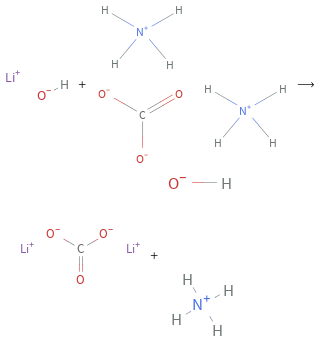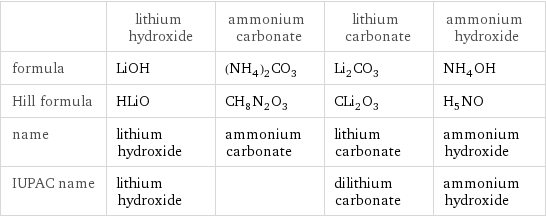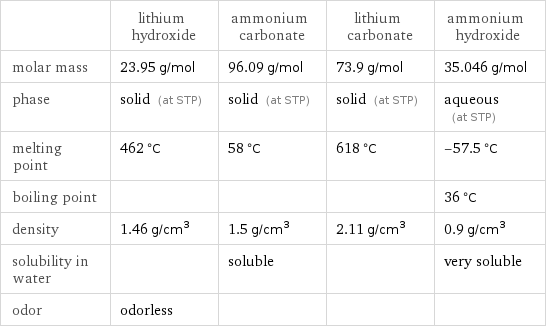Input interpretation

LiOH lithium hydroxide + (NH_4)_2CO_3 ammonium carbonate ⟶ Li_2CO_3 lithium carbonate + NH_4OH ammonium hydroxide
Balanced equation

Balance the chemical equation algebraically: LiOH + (NH_4)_2CO_3 ⟶ Li_2CO_3 + NH_4OH Add stoichiometric coefficients, c_i, to the reactants and products: c_1 LiOH + c_2 (NH_4)_2CO_3 ⟶ c_3 Li_2CO_3 + c_4 NH_4OH Set the number of atoms in the reactants equal to the number of atoms in the products for H, Li, O, C and N: H: | c_1 + 8 c_2 = 5 c_4 Li: | c_1 = 2 c_3 O: | c_1 + 3 c_2 = 3 c_3 + c_4 C: | c_2 = c_3 N: | 2 c_2 = c_4 Since the coefficients are relative quantities and underdetermined, choose a coefficient to set arbitrarily. To keep the coefficients small, the arbitrary value is ordinarily one. For instance, set c_2 = 1 and solve the system of equations for the remaining coefficients: c_1 = 2 c_2 = 1 c_3 = 1 c_4 = 2 Substitute the coefficients into the chemical reaction to obtain the balanced equation: Answer: | | 2 LiOH + (NH_4)_2CO_3 ⟶ Li_2CO_3 + 2 NH_4OH
Structures

+ ⟶ +
Names

lithium hydroxide + ammonium carbonate ⟶ lithium carbonate + ammonium hydroxide
Equilibrium constant
![Construct the equilibrium constant, K, expression for: LiOH + (NH_4)_2CO_3 ⟶ Li_2CO_3 + NH_4OH Plan: • Balance the chemical equation. • Determine the stoichiometric numbers. • Assemble the activity expression for each chemical species. • Use the activity expressions to build the equilibrium constant expression. Write the balanced chemical equation: 2 LiOH + (NH_4)_2CO_3 ⟶ Li_2CO_3 + 2 NH_4OH Assign stoichiometric numbers, ν_i, using the stoichiometric coefficients, c_i, from the balanced chemical equation in the following manner: ν_i = -c_i for reactants and ν_i = c_i for products: chemical species | c_i | ν_i LiOH | 2 | -2 (NH_4)_2CO_3 | 1 | -1 Li_2CO_3 | 1 | 1 NH_4OH | 2 | 2 Assemble the activity expressions accounting for the state of matter and ν_i: chemical species | c_i | ν_i | activity expression LiOH | 2 | -2 | ([LiOH])^(-2) (NH_4)_2CO_3 | 1 | -1 | ([(NH4)2CO3])^(-1) Li_2CO_3 | 1 | 1 | [Li2CO3] NH_4OH | 2 | 2 | ([NH4OH])^2 The equilibrium constant symbol in the concentration basis is: K_c Mulitply the activity expressions to arrive at the K_c expression: Answer: | | K_c = ([LiOH])^(-2) ([(NH4)2CO3])^(-1) [Li2CO3] ([NH4OH])^2 = ([Li2CO3] ([NH4OH])^2)/(([LiOH])^2 [(NH4)2CO3])](../image_source/bca750405040020abdd2f8d8f904ff50.png)
Construct the equilibrium constant, K, expression for: LiOH + (NH_4)_2CO_3 ⟶ Li_2CO_3 + NH_4OH Plan: • Balance the chemical equation. • Determine the stoichiometric numbers. • Assemble the activity expression for each chemical species. • Use the activity expressions to build the equilibrium constant expression. Write the balanced chemical equation: 2 LiOH + (NH_4)_2CO_3 ⟶ Li_2CO_3 + 2 NH_4OH Assign stoichiometric numbers, ν_i, using the stoichiometric coefficients, c_i, from the balanced chemical equation in the following manner: ν_i = -c_i for reactants and ν_i = c_i for products: chemical species | c_i | ν_i LiOH | 2 | -2 (NH_4)_2CO_3 | 1 | -1 Li_2CO_3 | 1 | 1 NH_4OH | 2 | 2 Assemble the activity expressions accounting for the state of matter and ν_i: chemical species | c_i | ν_i | activity expression LiOH | 2 | -2 | ([LiOH])^(-2) (NH_4)_2CO_3 | 1 | -1 | ([(NH4)2CO3])^(-1) Li_2CO_3 | 1 | 1 | [Li2CO3] NH_4OH | 2 | 2 | ([NH4OH])^2 The equilibrium constant symbol in the concentration basis is: K_c Mulitply the activity expressions to arrive at the K_c expression: Answer: | | K_c = ([LiOH])^(-2) ([(NH4)2CO3])^(-1) [Li2CO3] ([NH4OH])^2 = ([Li2CO3] ([NH4OH])^2)/(([LiOH])^2 [(NH4)2CO3])
Rate of reaction
![Construct the rate of reaction expression for: LiOH + (NH_4)_2CO_3 ⟶ Li_2CO_3 + NH_4OH Plan: • Balance the chemical equation. • Determine the stoichiometric numbers. • Assemble the rate term for each chemical species. • Write the rate of reaction expression. Write the balanced chemical equation: 2 LiOH + (NH_4)_2CO_3 ⟶ Li_2CO_3 + 2 NH_4OH Assign stoichiometric numbers, ν_i, using the stoichiometric coefficients, c_i, from the balanced chemical equation in the following manner: ν_i = -c_i for reactants and ν_i = c_i for products: chemical species | c_i | ν_i LiOH | 2 | -2 (NH_4)_2CO_3 | 1 | -1 Li_2CO_3 | 1 | 1 NH_4OH | 2 | 2 The rate term for each chemical species, B_i, is 1/ν_i(Δ[B_i])/(Δt) where [B_i] is the amount concentration and t is time: chemical species | c_i | ν_i | rate term LiOH | 2 | -2 | -1/2 (Δ[LiOH])/(Δt) (NH_4)_2CO_3 | 1 | -1 | -(Δ[(NH4)2CO3])/(Δt) Li_2CO_3 | 1 | 1 | (Δ[Li2CO3])/(Δt) NH_4OH | 2 | 2 | 1/2 (Δ[NH4OH])/(Δt) (for infinitesimal rate of change, replace Δ with d) Set the rate terms equal to each other to arrive at the rate expression: Answer: | | rate = -1/2 (Δ[LiOH])/(Δt) = -(Δ[(NH4)2CO3])/(Δt) = (Δ[Li2CO3])/(Δt) = 1/2 (Δ[NH4OH])/(Δt) (assuming constant volume and no accumulation of intermediates or side products)](../image_source/3363f137d4aedb54b2a804dfda89c259.png)
Construct the rate of reaction expression for: LiOH + (NH_4)_2CO_3 ⟶ Li_2CO_3 + NH_4OH Plan: • Balance the chemical equation. • Determine the stoichiometric numbers. • Assemble the rate term for each chemical species. • Write the rate of reaction expression. Write the balanced chemical equation: 2 LiOH + (NH_4)_2CO_3 ⟶ Li_2CO_3 + 2 NH_4OH Assign stoichiometric numbers, ν_i, using the stoichiometric coefficients, c_i, from the balanced chemical equation in the following manner: ν_i = -c_i for reactants and ν_i = c_i for products: chemical species | c_i | ν_i LiOH | 2 | -2 (NH_4)_2CO_3 | 1 | -1 Li_2CO_3 | 1 | 1 NH_4OH | 2 | 2 The rate term for each chemical species, B_i, is 1/ν_i(Δ[B_i])/(Δt) where [B_i] is the amount concentration and t is time: chemical species | c_i | ν_i | rate term LiOH | 2 | -2 | -1/2 (Δ[LiOH])/(Δt) (NH_4)_2CO_3 | 1 | -1 | -(Δ[(NH4)2CO3])/(Δt) Li_2CO_3 | 1 | 1 | (Δ[Li2CO3])/(Δt) NH_4OH | 2 | 2 | 1/2 (Δ[NH4OH])/(Δt) (for infinitesimal rate of change, replace Δ with d) Set the rate terms equal to each other to arrive at the rate expression: Answer: | | rate = -1/2 (Δ[LiOH])/(Δt) = -(Δ[(NH4)2CO3])/(Δt) = (Δ[Li2CO3])/(Δt) = 1/2 (Δ[NH4OH])/(Δt) (assuming constant volume and no accumulation of intermediates or side products)
Chemical names and formulas

| lithium hydroxide | ammonium carbonate | lithium carbonate | ammonium hydroxide formula | LiOH | (NH_4)_2CO_3 | Li_2CO_3 | NH_4OH Hill formula | HLiO | CH_8N_2O_3 | CLi_2O_3 | H_5NO name | lithium hydroxide | ammonium carbonate | lithium carbonate | ammonium hydroxide IUPAC name | lithium hydroxide | | dilithium carbonate | ammonium hydroxide
Substance properties

| lithium hydroxide | ammonium carbonate | lithium carbonate | ammonium hydroxide molar mass | 23.95 g/mol | 96.09 g/mol | 73.9 g/mol | 35.046 g/mol phase | solid (at STP) | solid (at STP) | solid (at STP) | aqueous (at STP) melting point | 462 °C | 58 °C | 618 °C | -57.5 °C boiling point | | | | 36 °C density | 1.46 g/cm^3 | 1.5 g/cm^3 | 2.11 g/cm^3 | 0.9 g/cm^3 solubility in water | | soluble | | very soluble odor | odorless | | |
Units
